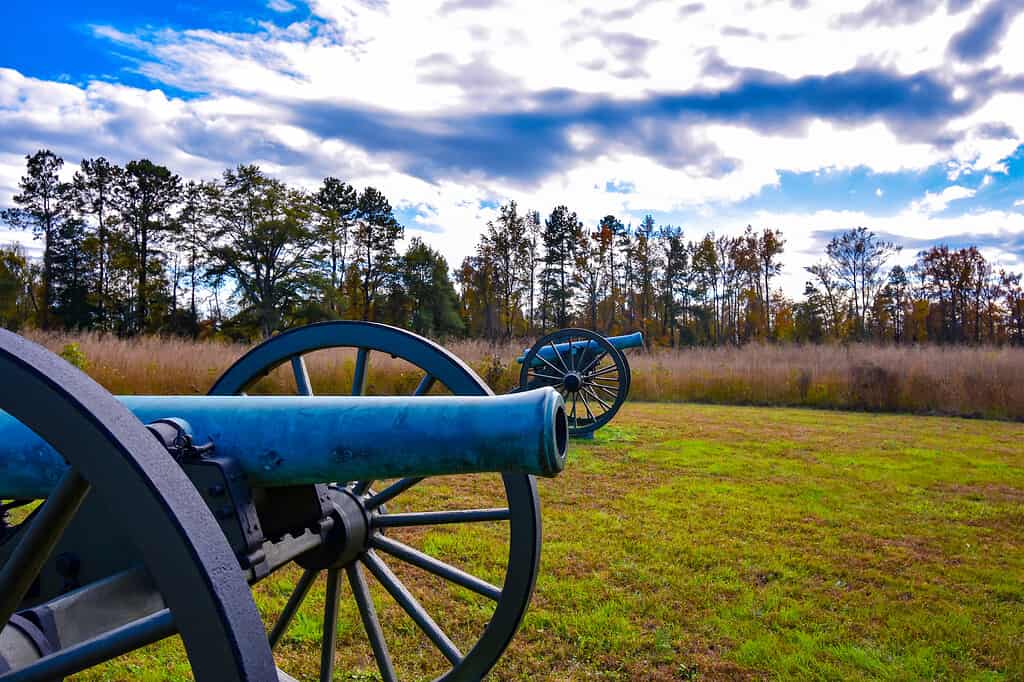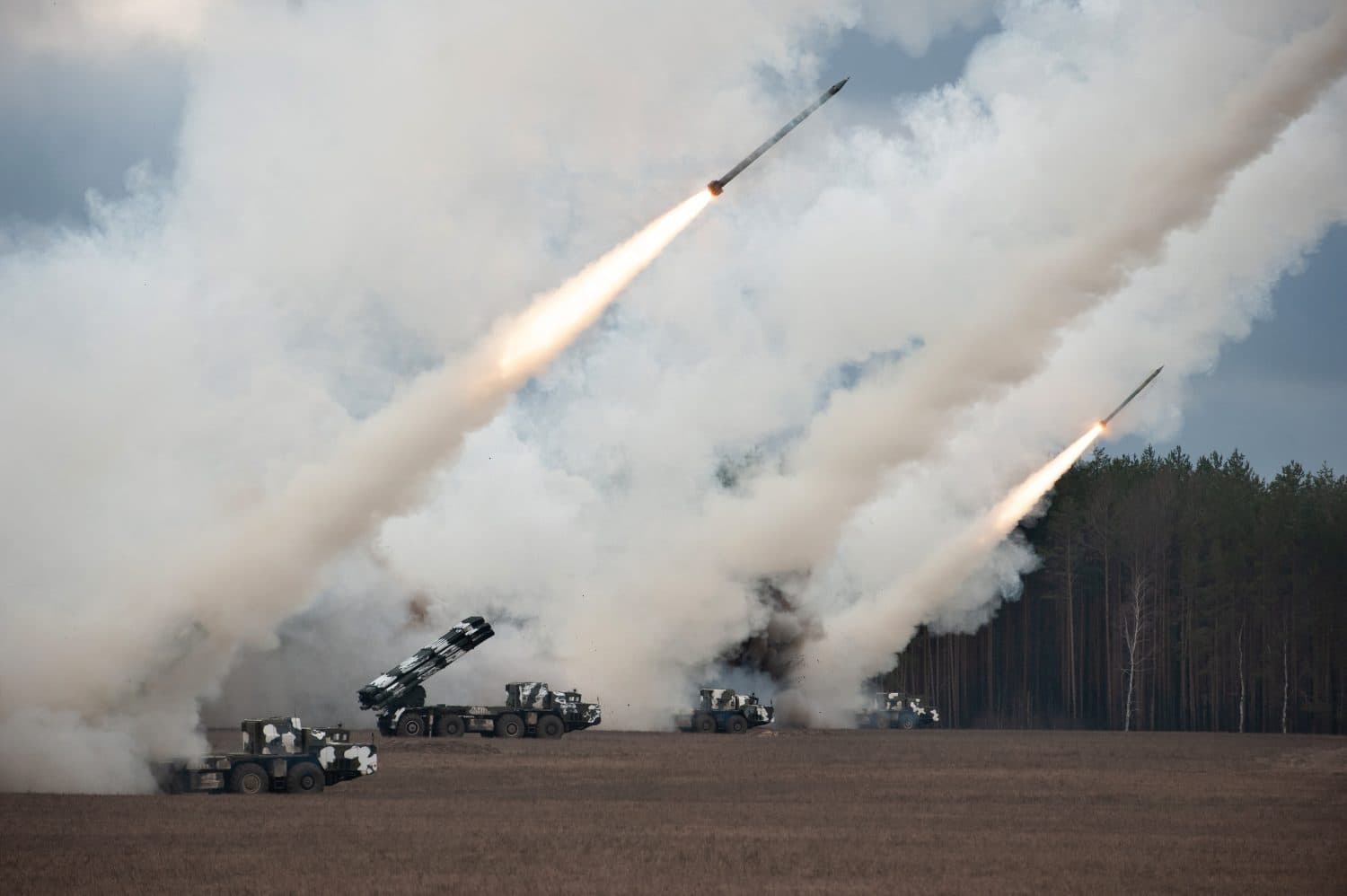The United States has a very large and powerful military. The nation needs large bases to train, house, and support its active service military members and their families. Surprisingly, one of the biggest and most populous military installations in the country is in North Carolina. Discover the largest military in North Carolina and find out how big it is, a bit about its history, and just how many people live on this base.
What Is the Largest Military Base in North Carolina?

Fort Liberty was originally an artillery training center.
©Grant Wylie/iStock via Getty Images
Fort Liberty (formerly Fort Bragg) is the largest military base in North Carolina, measuring 284.5 square miles or roughly 172,000 acres in total area. The facility is spread across Hoke and Cumberland counties.
The base has 23 miles of railroad and 1,400 miles of paved roads traversing the base. Roughly 85% of the base is dedicated to training grounds.
The massive military installation is home to divisions of the U.S. Army’s Airborne Corps, U.S. Army Special Operations Command, U.S. Air Force stations, and more. The base has a history dating back over a century, and it continues to transform to meet the needs of the military. Before considering the base’s history, let’s take a look at Fort Liberty’s location.
The Location of Fort Liberty
Fort Liberty covers parts of Cumberland and Hoke Counties in eastern North Carolina. The largest military base in North Carolina is bounded to the southeast by Fayetteville, a city with a population of 208,000 people. Spring Lake bounds the northern area of the base.
However, a large section of the base, especially weapons training grounds, stretches far to the west, ending to the east of Aberdeen.
The base is very large, allowing all sorts of training to occur in the area while also housing thousands of individuals.
The History of Fort Liberty

Today, Fort Liberty continues to host artillery training exercises.
©vblinov/Shutterstock.com
Fort Liberty has a long, storied history stretching back to 1918. Chief of Field Artillery General William Snow founded the original site of the camp. The region had the right combination of accessibility, low population density, climate, and water to be the site for a military base.
Originally, the encampment was called Camp Bragg, named for Braxton Brigg. The base’s original purpose was to serve as a training ground for artillery squads. The large, sparsely populated area helped the military conduct all sorts of training without worry.
Camp Bragg was originally opened in February 1919, just months after the end of World War I.
The base fulfilled its purpose as an artillery range and even had an airfield. Although the camp was slated for closure in 1921, a concerted effort on the part of General Albert Bowley helped avert the closing.
In 1922, the base became a permanent fixture for the U.S. Army. As a result, it was renamed to Fort Bragg. Between 1918 and 1923, the U.S. War Department bought 50,000 acres of land in the region. The base served as an important training ground for soldiers, and it continued to grow.
Over the years, soldiers trained at this base for deployment into World War II, Operation Just Cause, Operation Desert Shield/Desert Storm, and various humanitarian efforts at home and abroad.
The largest military base in North Carolina is one of the largest in the world by population and size.
Changing Names and Maintaining Purpose

The U.S. government has worked to rename military installations named after Confederate soldiers.
©RockingStock/iStock via Getty Images
The 2021 National Defense Authorization Act (NDAA) made several changes to the military. As a part of this legislation, several bases in the United States were renamed. In the case of Fort Bragg, the U.S. government decided to change its name to Fort Liberty. After all, Braxton Brigg was a Confederate general, and it would be inappropriate for a United States military installation to bear his name.
Fort Liberty is not named for any individual or group. Instead, its name stems from a closely held American principle that allows the facility to “honor American heroes whose valor, courage, and patriotism exemplify the very best of the United States military.”
The Population at Fort Liberty

Fort Liberty is home to tens of thousands of soldiers.
©Seneline/Shutterstock.com
One of the most fascinating aspects of Fort Liberty is the number of people living on the base. According to the U.S. Army, the base is home to about 57,000 military personnel, 11,000 civilian employees, and 23,000 family members. Nearly 100,000 people live in this region.
The Department of Defense lists an even higher population. They say the base has about 45,000 active-duty soldiers, 2,000 reservists, 27,000 retirees, 16,000 civilians and contractors, and another 98,000 military family members in the region.
Meanwhile, NAWS China Lake is a much larger base in California. This military installation measures 1.1 million acres or 1,718.75 square miles. However, the base only houses about 6,000 people. A better comparison would be Camp Pendleton North, a base that has 42,000 individuals living on the base. Fort Liberty has a much larger population than one of the largest, most-renowned bases in the country.
All in all, Fort Liberty remains the largest military base in North Carolina and one of the biggest in the country in terms of size and population. The “Home of the Airborne and Special Operations Forces” continues to meet the needs of military training and operations.
The photo featured at the top of this post is © iStock.com/albertc111
Thank you for reading! Have some feedback for us? Contact the AZ Animals editorial team.







